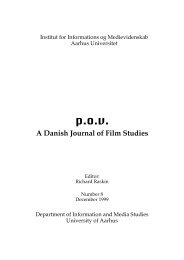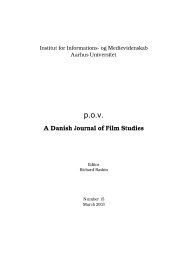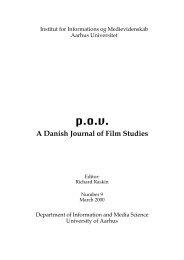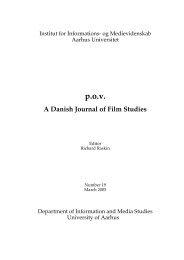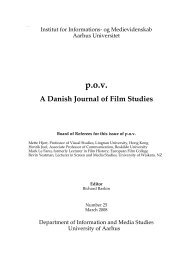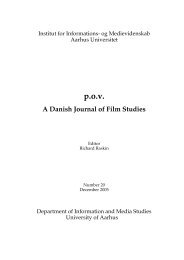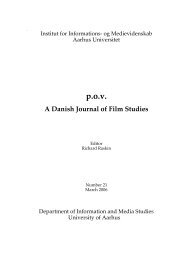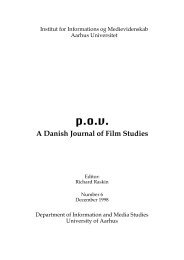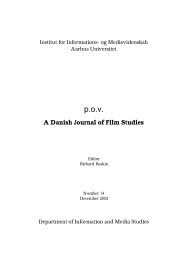The Face of Time - POV - Aarhus Universitet
The Face of Time - POV - Aarhus Universitet
The Face of Time - POV - Aarhus Universitet
Create successful ePaper yourself
Turn your PDF publications into a flip-book with our unique Google optimized e-Paper software.
78 p.o.v. number 13 March 2002<br />
Kieslowski about his minimal narrative style when asked about<br />
what the film school in Lodz taught him: “<strong>The</strong> Film School taught<br />
me how to look at the world. It showed me that life exists and that<br />
people talk, laugh, worry, suffer, steal, in this life, that all this can be<br />
photographed and that from all these photographs a story can be<br />
told. I didn't know that before” (Kieslowski in Danusia Stok, 1993:<br />
46-47).<br />
In this little film the story told by a montage <strong>of</strong> situations and<br />
small human portraits is one <strong>of</strong> old people on trial. It is also a story<br />
showing how these people simply don’t understand how they can<br />
be on trial and the kind <strong>of</strong> system that produces this atmosphere <strong>of</strong><br />
trial. But the camera reveals this and moves from the surface and<br />
deep into the heart <strong>of</strong> bureaucracy. Words, images, gestures, facial<br />
expressions, body language and so on, everything speaks in this<br />
film, revealing the system and its inhumane and ‘Kafkaesque’<br />
nature.<br />
<strong>The</strong> film is clearly divided into three rhetorical and visual<br />
statements and forms. <strong>The</strong> first part <strong>of</strong> the film is characterized by its<br />
impersonal, <strong>of</strong>f-screen dialogue between clients and clerks. <strong>The</strong><br />
dialogue is about forms and stamps that are missing; formulas and<br />
paperwork seem to rule everything here. No dialogue ever deals<br />
with the real social problems, but only with correct or incorrect procedures.<br />
So it is quite symbolic that the film disembodies the voices<br />
and that the camera at the same time moves around catching short<br />
glimpses <strong>of</strong> troubled faces, nervous hands fumbling with papers<br />
and so forth. <strong>The</strong> framing goes from medium to ultra close up,<br />
furthermore underlining the disembodied and alienating treatment<br />
<strong>of</strong> humans. <strong>The</strong>y never seem to step out as distinct, concrete<br />
persons; they are just clients, faces, and passing things.



